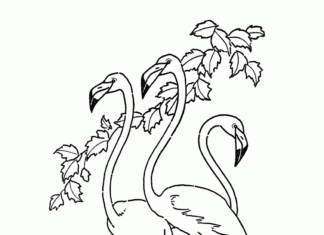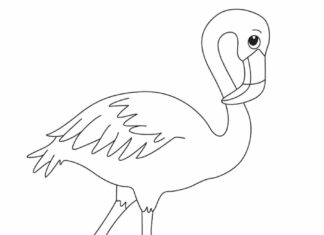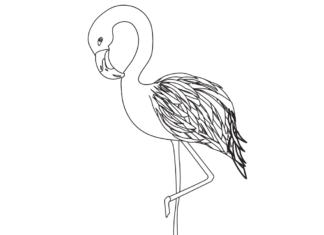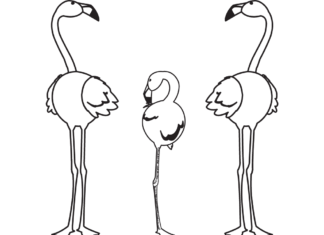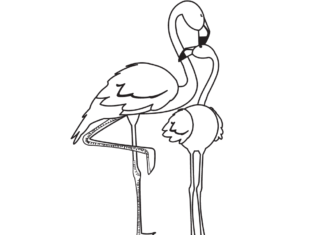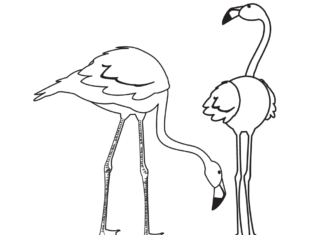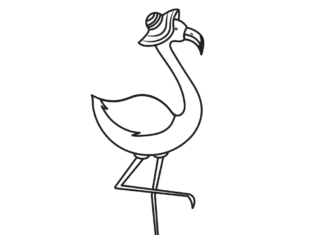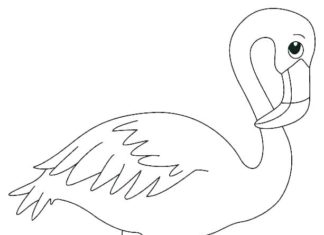One of the larger ones that comes from a species of wading bird in the flamingo family. Most commonly inhabit the Yucatan Peninsula and the northern coasts of South America. It has a rare red color of its plumage. In our country it does not occur in its natural environment because it is not favorable for it, but there are two zoos where we can see it.
Coloring Book Flamingos
Information
- Classification: Flamingos are birds of the flamingo family (Phoenicopteridae). There are six species of flamingos, which vary in size, plumage colors and habitat.
- Occurrence: Flamingos inhabit a variety of habitats around the world, from salt lagoons to mountain lakes in Africa, Asia, America and Europe.
- Plumage: A characteristic target of flamingos is their pink plumage. This color comes from carotenoids present in their diet. These chemicals are converted into pink and red pigments that accumulate in their feathers, skin and beak.
- Beak: Flamingos have a unique curved beak that is used to filter food from the water.
- Diet: Their main food is tiny organisms such as algae, small crustaceans and bacteria that live in salty waters.
- Stand on one leg: Flamingos are known for adopting a standing position on one leg. Why they do this is still a topic of debate, but one theory is that it helps them stay warm.
- Reproduction: Flamingos gather in large colonies, which sometimes number up to thousands of birds, during the breeding season. These birds form pairs that often stay together for many years.
- Sockets: Flamingos build nests from mud in the shape of a mound, where they lay their eggs. Only one egg is laid, and both parents participate in its incubation.
- Hikes: Although some flamingo species are sedentary, others migrate in search of better feeding habitats or breeding sites.
- Protection status: Many flamingo populations are stable, but some species are endangered due to habitat loss, human disturbance and other factors.
Trivia
- Pink feathers: Although young flamingos are born with gray plumage, they turn pink by eating shrimp rich in carotenoids. The color of their feathers is directly proportional to the amount of crustaceans consumed.
- Salt as environment: Flamingos often inhabit waters with high salt concentrations. Their feet can withstand high levels of brine, allowing them to stay in such environments without irritation.
- Filtering the food: They have specially adapted beaks and tongues to filter food from water. They hold their heads upside down while eating.
- Dance: Flamingos perform complex dance rituals during courtship that include flapping their heads, swaying and flapping their wings.
- Long legs and neck: Flamingos have some of the longest legs relative to their bodies among birds. These enable them to wade through deep waters in search of food.
- Low oxygen needs: Flamingos have extremely small lungs relative to their body size, but are able to survive in high-altitude lakes where air is scarcer.
- Groups: These birds are very social and often form large groups that can number in the thousands or even millions of individuals. In such groups it is easier for them to find food and defend themselves from predators.
- Construction of nests: Flamingos build nests from mud in the shape of a mound to protect their eggs from flooding water and from predators.
- Communications: Flamingos communicate with each other using a variety of sounds, from loud honking to quiet cooing, which are used to express emotions, warn of danger or attract a mate.
- Sight: They have very good eyesight, which helps them find food in murky waters and maintain contact with other flock members over long distances.

